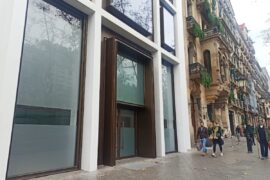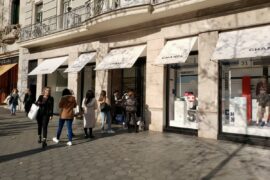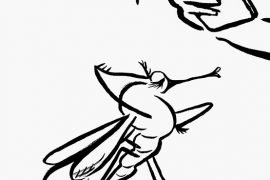Street theater and Tàrrega, terms that have become synonymous in Catalonia: please do forgive me for the cliché. The Fair takes place from September 6th to 9th in its 38th edition with a menu of shows that once again seeks to offer a qualitative leap, bringing new experiences in this genre, which has ceased to be minor for a long time now. The sceneries of Fira Tàrrega become participative spaces, where the audience interacts with the theatrical piece to the point of turning into an unexpected protagonist.
Jordi Duran, captain of this artistic flagship for eight years now, is in love with theater and arts in general. Active, proactive and tireless. Duran’s head is buzzing with ideas that become new challenges. One of them is to overcome the classism that -he explains- still survives in the artistic world, in order to share illusions and experiences with other festivals, through co-productions, for example. In his last year in charge of FiraTàrrega, he will put in the foreground “the reinterpretation of the public space, increasingly marked by the present and the environment”. As for his upcoming departure from the direction of the fair, ensures that “we are all dispensable” and hopes that, without him, the contest “will be stirred and able to rebuild and improve in the future.” In our talk, he reveals his concerns, and explains how FiraTàrrega 2018 is being prepared, his edition last as artistic director.
This edition number 38 of FiraTàrrega closes a triennium that has vindicated the street arts. Interculturality, Participation and Public space have been the key ideas. What is sought in this edition?
The idea is to re-read the public space. This triennium was to reclaim the assets of street arts. We came from the editions of 2011 to 2015, we come from explaining or trying to understand that the street arts are not just street theater. Now we make a synchronic and diachronic reading of what we are and what we have been, because I think that since October 1st, public space and its meaning have changed. I’m not talking about using the fair as a space to make a pamphlet, but it is important to question the audience, to hear what is happening and who we are. What worries our artists must have a place in the street arts. Thus, the fair becomes a balance of equilibria, but also a space to have fun and laugh. It’s a roller coaster of experiences. We must be able to separate ourselves from the problems, but also be able to look them in the face.
Since taking the reins of the direction of the festival, this has been strengthened in the vocation to go beyond conventional street theater. What projects help to make this chip change?
During five editions (from 2011 to 2015) we dedicated the fair to different scenic categories: circus, new technologies, dance, theater and visual arts. Since 2015, we have incorporated more scenic pieces that hybridize with the visual arts. It is increasingly natural for public space to be a space for live art. After these five years, this concept had already come together and now we insist on the reason for the street arts today. We appeal to the public, institutions, professionals, universities… We must encourage more research in this line. The fair must be a place where everyone finds a piece.
This year there will be 50 premieres from 8 different countries. In past editions the Fira had more premieres, but the obsession with numbers seems to be over, already left behind…
It has been a while since we work having quality in mind, and thinking about how to promote experiences. We do performing arts, not parties. For that, we already have Primavera Sound, Sónar… here we are for art. For this reason, we fight so that the artists can work in good conditions. We do not want to contribute to the precariousness of the sector. FiraTàrrega takes into account and cares for the people who program. When 100 or 120 shows where done, it was unattainable. Now we have 50 shows, it is accessible, and the programmer has the feeling that he sees many things and does not miss so many.
Let’s talk about one of your strongest achievements as director of the Fair. It is the Program of Support for Artistic Creation. This year, thanks to this initiative, the public will be able to enjoy 12 new productions.
In 2011, I presented a project to open and change the model. This change had to happen, in order to be in the sector from education, and also involve its architects in the project. For this reason, the creation of a Master of Street Arts was proposed, jointly with the University of Lleida. From here arise names that will later perform at different festivals. The other part is the support of creation. We are fortunate and Tàrrega is open from February to September so that everything happens. People come, stay, try if it is the best place to act or do tests with the public of the city. Education, support for creation and the Fair. In recent years we put a lot of will to transcend the ‘supermarket’ way of proceeding, that is, not only do we want to sell the product, but we explain that there are people behind, ways of doing and programming.
In the current edition, the Fira wants to a look at the past to understand the present and the present to face the future. What are you looking for?
Looking at the past, and I speak of a contemporary past, seems important since there are works that have been made in the last 5 years in Europe but never seen here. They need to be seen, because they point to the direction where contemporary street theater may evolve, and explain things that concern us today.
Present is people who work from today, and the things that are happening now. We have the example of Les Impuxibles [one of the companies that are part of the poster of this edition’s fair], who have the need to use art as a speaker of denunciation and social change, positioning themselves in a policy of equalities. And all this helps us to look to the future. FiraTàrrega is committed to breaking the ice and presenting people who are about to take off, like Ariadna Coca, Emilia Garabato, Claudia González. It is a balance between past, present and future possibilities. It is about attending risk, understood as value and as a point of interest, both to professionals from here and abroad.

This year FiraTàrrega has invited 16 international shows. The Mexican and Chilean proposals stand out, with which you have been working for a long time. Why do you look at these countries? Will this commitment continue in the future?
These dalliances must be understood as ways to have markets activated. The great market of the Fair is Europe, but if we want to go out it is important to create links through co-productions. Pieces that cross our borders must be welcomed. For reasons of language, with Spanish we connect fast and we cannot not listen to it. A kind of bridge has been established between countries such as Chile or Mexico and Tàrrega. This January we present 4 pieces of Catalan street art in Santiago de Chile. And this will continue. A clear example of this good understanding is that this year a co-production is presented at the Fair, made by Latin students of the Master of Street Arts and the playwright Sergi Belbel. It’s called Mexicatas. Belbel is responsible for the dramaturgy, and it is very beautiful because there are things that come out of the fair and transcend it. This year we also have the Mexican playwright Antonio Zúñiga, who accepted the task of FiraTàrrega to write a theatrical text for public space based on historical memory, intended for spectators from 6 years. Melina Pereyra directs Chroma Teatro in this poetic and magical piece called Prácticas de vuelo para acabar con el olvido (“Flight practices to end oblivion”), which will be performed in the cemetery of the capital of Urgell.
Is there still a stigma, a certain contempt, towards the street arts? Often there are those who link them to traditional fests.
I think there is classism among the arts. Between institutions, people who study, universities, places where artists are trained, and so on. There still are a lot of prejudices towards the street art and people who see it as a minor genre or ‘low culture’. But we care about facts, and not words! Therefore, we will continue working on this line.
What is the future of FiraTàrrega?
I think that the Fair must listen to the time it lives and must incorporate the opinion, the vision of everyone who is part of the Fair family. I am now finishing a project that must be stirred, questioned and deconstructed, in order to rebuild and improve what it represents. We are all dispensable and I would like that it takes new directions.




















